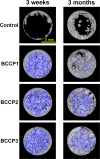The effect of synthetic bone graft substitutes on bone formation in rabbit calvarial defects
- PMID: 33475862
- PMCID: PMC7819904
- DOI: 10.1007/s10856-020-06483-6
The effect of synthetic bone graft substitutes on bone formation in rabbit calvarial defects
Abstract
The aim of this study was to evaluate the influence of the intensity of the biomimetic hydroxyapatite (HA) coating of α-tricalcium phosphate (α-TCP) on biomaterial degradation and bone formation. Twenty-four female NZW rabbits of approximately 12 weeks of age were used. Critical size defects were randomly treated with 3%:97% HA:α-TCP (BBCP1), 12%:88% HA:α-TCP (BBCP2), and 23%:77% HA:α-TCP (BBCP3), respectively or sham. All defects were covered with a resorbable collagen membrane. Animals were euthanized after 3 and 12 weeks of healing and samples were investigated by micro-CT and histologic analysis. Ingrowth of newly formed woven bone from the original bone at 3-week healing period was observed in all samples. At the 12-week healing period, the new bone in the peripheral area was mainly lamellar and in the central region composed of both woven and lamellar bone. New bony tissue was found on the surface of all three types of granules and at the interior of the BBCP1 granules. Samples with 3% HA showed significantly less residual biomaterial in comparison to the other two groups. Furthermore, BBCP1 significantly promoted new bone area as compared to other three groups and more bone volume as compared to the control. Within its limitations, this study indicated the highest degradation rate in case of BBCP1 concomitant with the highest rate of bone formation. Hence, formation of new bone can be affected by the level of biomimetic HA coating of α-TCP.
Conflict of interest statement
The authors have no financial interest to declare in relation to the content of this article. Mr Claudio Zihlmann is employed by Geistlich Pharma AG (Wolhusen, Switzerland).
Figures














Similar articles
-
Bone regeneration in rabbit calvarial critical-sized defects filled with composite in situ formed xenogenic dentin and biphasic tricalcium phosphate/hyroxyapatite mixture.J Biomed Mater Res B Appl Biomater. 2019 Apr;107(3):773-782. doi: 10.1002/jbm.b.34171. Epub 2018 Sep 25. J Biomed Mater Res B Appl Biomater. 2019. PMID: 30253039
-
Bone Regeneration Potential of Biphasic Nanocalcium Phosphate with High Hydroxyapatite/Tricalcium Phosphate Ratios in Rabbit Calvarial Defects.Int J Oral Maxillofac Implants. 2016 Mar-Apr;31(2):294-303. doi: 10.11607/jomi.4531. Int J Oral Maxillofac Implants. 2016. PMID: 27004276
-
Effects of additional collagen in biphasic calcium phosphates: a study in a rabbit calvaria.Clin Oral Investig. 2020 Sep;24(9):3093-3103. doi: 10.1007/s00784-019-03181-8. Epub 2020 Jan 17. Clin Oral Investig. 2020. PMID: 31953682
-
Evaluation of the osteoconductivity of α-tricalcium phosphate, β-tricalcium phosphate, and hydroxyapatite combined with or without simvastatin in rat calvarial defect.J Biomed Mater Res A. 2011 Sep 15;98(4):488-98. doi: 10.1002/jbm.a.33117. Epub 2011 Jun 16. J Biomed Mater Res A. 2011. PMID: 21681941
-
[Integration properties of bone substitute materials. Experimental studies on animals].Orthopade. 1998 Feb;27(2):105-17. doi: 10.1007/s001320050208. Orthopade. 1998. PMID: 9530667 Review. German.
Cited by
-
Impact of Cross-Linking of Collagen Matrices on Tissue Regeneration in a Rabbit Calvarial Bone Defect.Materials (Basel). 2021 Jul 4;14(13):3740. doi: 10.3390/ma14133740. Materials (Basel). 2021. PMID: 34279311 Free PMC article.
-
Combined use of deproteinized bovine bone mineral and α-tricalcium phosphate using gelatin carriers.BMC Oral Health. 2025 Feb 21;25(1):275. doi: 10.1186/s12903-025-05644-9. BMC Oral Health. 2025. PMID: 39984888 Free PMC article.
-
Dual-functional 3D-printed porous bioactive scaffold enhanced bone repair by promoting osteogenesis and angiogenesis.Mater Today Bio. 2024 Jan 4;24:100943. doi: 10.1016/j.mtbio.2024.100943. eCollection 2024 Feb. Mater Today Bio. 2024. PMID: 38269054 Free PMC article.
-
Innovative Concepts and Recent Breakthrough for Engineered Graft and Constructs for Bone Regeneration: A Literature Systematic Review.Materials (Basel). 2022 Jan 31;15(3):1120. doi: 10.3390/ma15031120. Materials (Basel). 2022. PMID: 35161065 Free PMC article. Review.
-
Addition of Synthetic Biomaterials to Deproteinized Bovine Bone Mineral (DBBM) for Bone Augmentation-A Preclinical In Vivo Study.Int J Mol Sci. 2022 Sep 10;23(18):10516. doi: 10.3390/ijms231810516. Int J Mol Sci. 2022. PMID: 36142427 Free PMC article.
References
-
- Moy P, Palacci P. Minor bone augmentation procedures. In: Palacci P, Ericsson I, editors. Esthetic implant dentistry. Soft and hard tissue management. Quintessence Publishing Co: IL.
MeSH terms
Substances
LinkOut - more resources
Full Text Sources
Other Literature Sources

